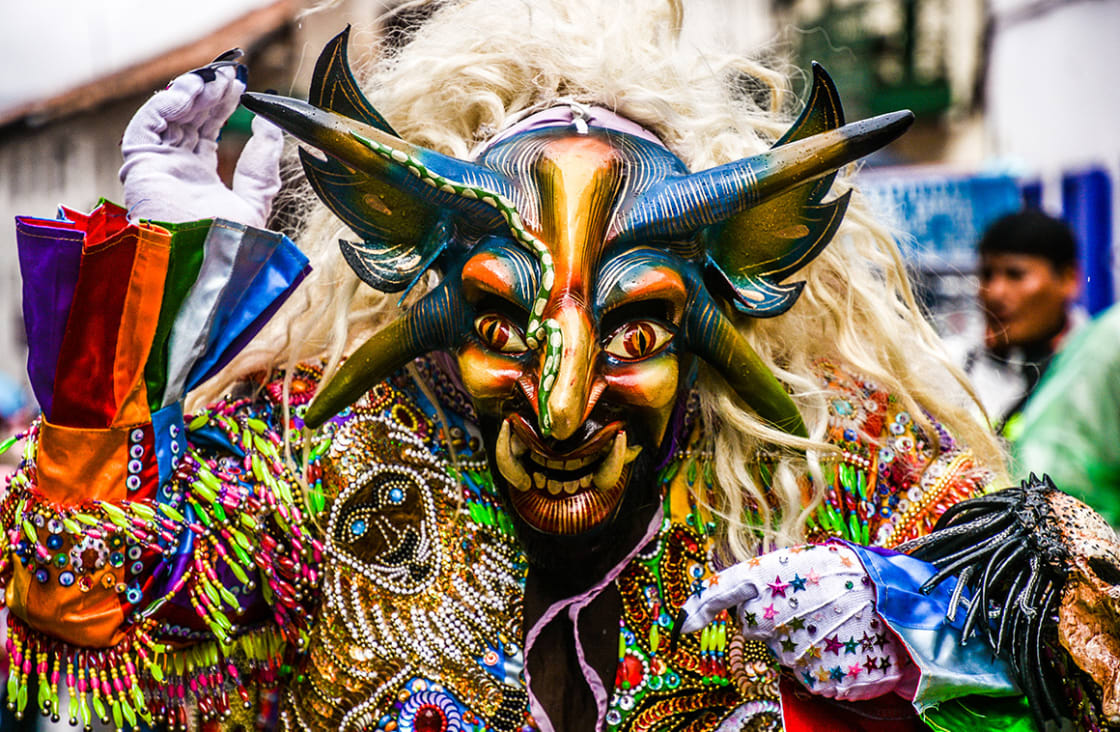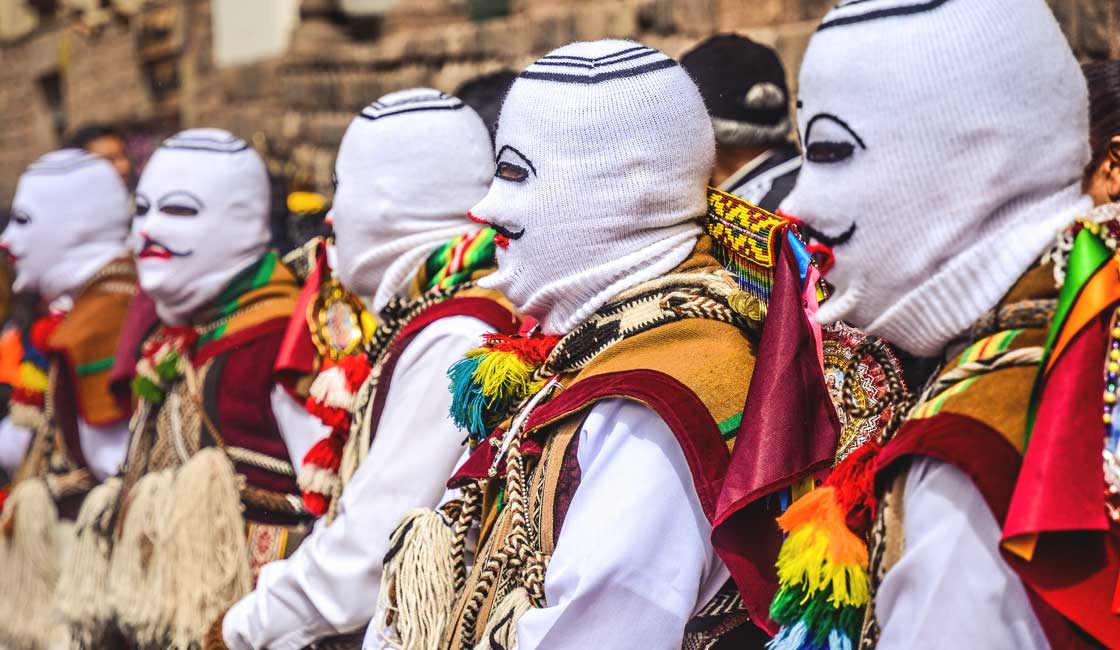
The famous Incas of Peru held four major religious celebrations each year, the largest and most important of which was Inti Raymi, attracting pilgrims from all corners of the Inca Empire. This annual Andean celebration continues to this very day, and is South America’s second-largest festival after Carnival in Rio de Janeiro, with travelers from all corners of the globe now in attendance to witness the spectacular reenactment of the original proceedings. Here we take an in-depth look into Inti Raymi, its origins, and evolution into one of the must-see spectacles for visitors to Peru.

Costumes
Inti Raymi was the most important traditional religious ceremony of the Inca Empire and is still celebrated in indigenous cultures throughout the Andes. It honors the return of their most venerated god, Inti, the Quechua word for “sun”, gives thanks to Pachamama (Mother Earth) to ensure good crops for the upcoming Andean new year, and historically also paid tribute to the Inca, the firstborn son of the Sun.
Raymi in Quechua signifies either an equinox or solstice, so although it has no literal English translation is often interpreted as a “religious festival”, hence Inti Raymi is more commonly known as a religious “festival of the sun”.
Those who know your festivals will notice that Inti Raymi coincides with (or is also known as) the Fiesta of San Juan in parts of the Amazon where water is more revered. This is because the Spanish conquistadors considered Inti Raymi to be a heathen celebration and so in an attempt to hide its popularity merged it with the Catholic celebration for Saint John the Baptist.
Inti Raymi is held annually on June 24th in Peru (June 22nd in Ecuador) around the dates of the Southern Hemisphere’s winter solstice. The first Inti Raymi in history was in 1412, and continued to be celebrated until 1572 – even after the execution of the last Inca in 1533 – when Viceroy Francisco de Toledo officially banned the celebration along with many other Inca traditions. In 1944, the first historical reenactment of Inti Raymi took place, and its popularity has led to its continued celebration every year since.

Costumes vary between regions and villages
Inti Raymi is celebrated throughout the Andean Highlands, but the largest celebrations are at Otavalo or Ingapirca in Ecuador, and Cusco in Peru.
Every year, up to 25,000 people would travel from the four suyus (provinces) of Tawantinsuyu (the Inca Empire) – Chinchaysuyu (north), Qullasuyu (south), Antisuyu (east), and Kuntisuyu (west) – and descend in their droves upon Cusco, the Inca capital, for the festival.
The celebration was held in the main plaza of the city, known then as the Haukaypata, and were carried out by the Sapa Inca, nobility, priests and the army generals. For the ceremonial participants mentioned, the three days preceding the festival were a period of purification, the strict diet of water, uncooked white maize and a regional herb called chucam the only sustenance allowed.
The night before the big day the participants would gather in the plaza to wait respectfully in silence for the appearance of the Sun god Inti between the mountains. At dawn on June 24th they would remove their shoes and face the rising sun, crouching down and blowing kisses as a sign of respect, before raising two golden cups filled to the brim with offerings. The left-hand cup was an offering for the sun, the right-hand cup for the Sapa Inca.
Later a parade of royal ancestral mummies brought from nearby temples and shrines would take place around the main square. To a fanfare of sea shell musical instruments the Sapa Inca would take to the stage in front of the throngs of attending pilgrims – many of whom would paint their face yellow and wear deer antler headdresses – and drink chicha de jora, the Incan beer, in honor of the Sun god, Inti.
A priest would light a flame inside the Qorikancha (Temple of the Sun) and their black llamas in their hundreds were cut open with a tumi, a ceremonial knife, and their organs analyzed for omens and burnt as offerings to Pachamama, so many in fact that the streets would regularly run red with blood. In times of hardship when crop production was particularly low, it is thought children of each province were even sacrificed.
Following days of colorful dances and processions, the Inca would return to his palace to mark the ending of the celebrations, a carpet-like scattering of feathers and flowers unraveling before his feet as he went.

Full costume
You could visit different Andean towns and villages and never celebrate Inti Raymi in the exact same way as each tends to have their own traditions, dances, costumes and customs, however, in general, they will all involve music, masks, moonshine and plenty of food, with parties often going on into the small hours.
Inti Raymi begins with at midnight (or with the light of dawn) when locals flock to the nearby springs, rivers and waterfalls together to take part in armay chisi, ritual bathing to replenish their connection to Pachamama and spiritually cleanse and purify the soul.
Later in the day towards noon, at the height of the sun’s passage through the sky, parades and large communal gatherings are held. At the celebrations keep your eyes peeled for the following colorful characters:
It’s important to remember that at it’s roots, Inti Raymi is a celebration of harvest and abundance, so naturally food and drink plays an important role in festivities. Many communities prepare a Pampamesa (“Food for All”), where a communal picnic is laid out with the Andean staples of potatoes, corn, and pork, and everyone sits on the floor and eats with their hands to get a closer connection to Mother Earth. There is also a plentiful supply of Chicha de Jora, the local moonshine made from fermented corn.

Costumes also draw inspiration from the Spanish catholicism
Despite being more theatrical than the ancient rituals once observed, the Inti Raymi celebrations in Cusco are still more formal than in the surrounding towns and villages, with a choreographed sequence of dances and scenes performed by some 700 actors, dancers and musicians. The focus of the festival changes throughout the day between the following locations:
If you wish to watch the finale of the Inti Raymi festival at Sacsayhuaman you will need to buy tickets in advance, but otherwise, you can see the Inti Raymi procession at spots within Cusco along the processional route between the Qorikancha (Temple of the Sun) on Avenida El Sol and the Plaza de Armas in the morning. For those attending, we have created a list of 10 useful tips:
While Rainforest Cruises aim to provide accurate and up-to-date information, we make no representations as to the accuracy or completeness of any information herein or found by following any link on this site. Rainforest Cruises cannot and will not accept responsibility for any omissions or inaccuracies, or for any consequences arising therefrom, including any losses, injuries, or damages resulting from the display or use of this information.




